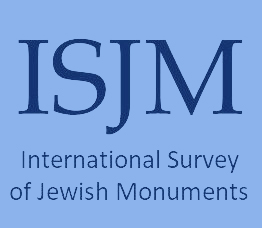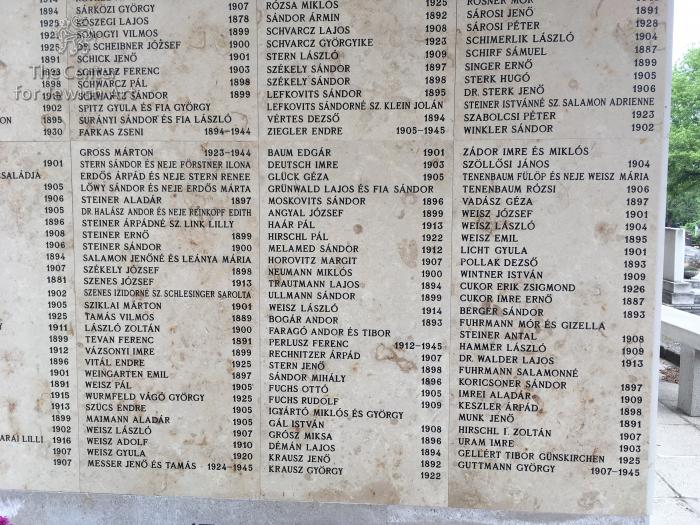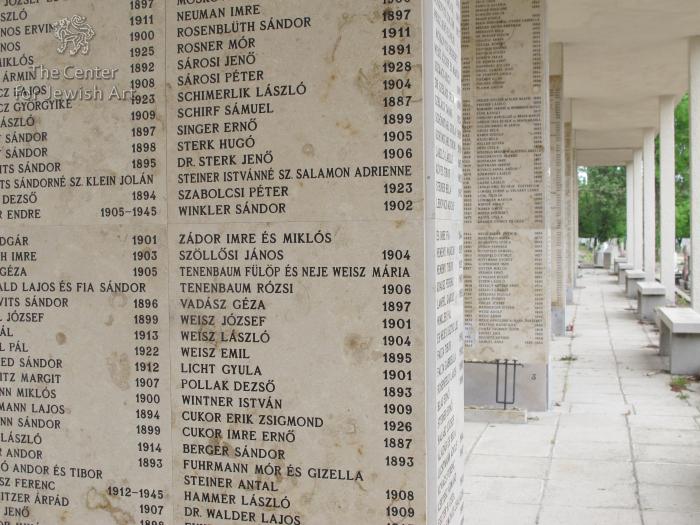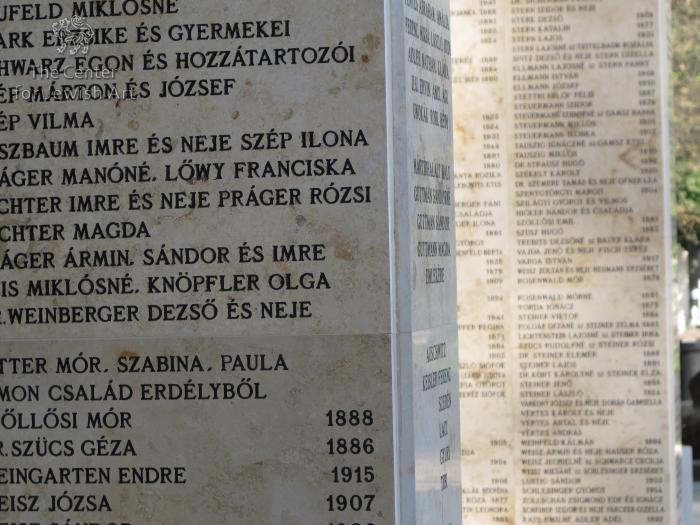Obj. ID: 48329 Holocaust Memorial at the Kozma Street Cemetery in Budapest, Hungary, 1949

Memorial Name:
Martyrs’ Memorial for Victims of the Holocaust
Who is Commemorated?
Hungarian victims of the Holocaust
Description
The memorial is built as an open L-shaped pavilion on two sides of a rectangular open space. The entire structure sits on a continuous concrete (?) slab base. A large two-step concrete slab is set in a part of the open space. The memorial encloses two sides of the open space, which is used for memorial gatherings.
One end of the monument on the short side of the rectangular space, facing the center, is a tall wall of large squared brown stone blocks in the middle of which is a full-height white wall of evenly cut limestone (?) panels, at the top of which is written in high-relief Hebrew letters “Yizchor”. Beneath this is an inscription in Hebrew and Hungarian (these have slightly different texts). In front of this memorial wall is a black marble vault. To the right of the vault is a menorah.
Extending out from this, at lower height, is an open pavilion constructed of nine (?) straight, flat walls and a row of thin concrete (?) piers along the outer edge that support a flat roof. The roof curves slightly as it changes direction. Three bays are on the short side next to the Remembrance Wall, and six (?) bays are on the long side. Along the entire length of the pavilion, between the outer perimeter supporting piers and the inscribed walls, are simple stone benches. These are each made of three stone blocks – two supports, and one for the seat.
Inscribed on the nine stone walls of the two-winged arcade memorial are tens of thousands of names, some of the about 600,000 Hungarian Jews who were murdered in the Holocaust and are known by name. Many names were added later, in pencil.
At the top of each wall is a Biblical inscription in Hebrew and Hungarian [listed (and translated) below]. At the bottom of each wall is the Hebrew commemorative abbreviation ת.נ.צ.ב.ה, an abbreviation customarily put at the bottom of a gravestone representing the Hebrew words תהא נפשו/ה צרורה בצרור החיים (t'hay nafsho/ah tzrurah b'tzror hachaim), "May his/her soul be bound up in the bond of life."
Each side of each wall is lined with four columns and three rows of marble plaques inscribed with victims' names. Inscribed across the tops of all four columns in the top row of panels are inscribed in larger letters the names of major killing sites - Bergen Belsen, Auschwitz, Mauthausen, Magyarorszag (Hungary) - and the inscription “Ismeretlenben Elhal Tak” (they died unknown) ...
Three plaques are also affixed to the side of each wall. Victim’s name and date of birth (when known). The names are not listed alphabetically or by date, but the walls are numbered and there is an index of all names listed.
At the very end of the pavilion, there is a wall of the same large squared brown stone blocks of the tall memorial wall at the beginning. In front of this – facing out - is a fountain, the back of which is in the shape of the Tablets of the Law. In front of this is a water basin.
Inscriptions
On both sides of the walls, above the names, there are quotations, from left to right:
Hebrew
אחינו בני ישראל שמסרו נפשים
על קדושת השם
Hungarian
Megölte öket a gyülölet-
örizze emléküket a szeretet
Translation: Our brothers, the sons of Israel, who sacrificed their lives for the holiness of the Name.
Hebrew
To be transcribed
Hungarian
To be transcribed
Translation: They were murdered by hatred— their memory should be preserved by love.
Hebrew
על אלה חשכו עינינו
Hungarian
Miattuk homályosodnak szemeink
Translation: Because of these our eyes are dimmed (Lamentations 5:17, JPS 1985)
Hebrew
כי־עלה מות בחלונינו
Ablakainon rontott be a halál
Translation: For death has climbed through our windows (Jeremiah 9:20, JPS 1985)
Hebrew
וספדה הארץ משפחות משפחות לבד
Hungarian
need to transcribe
Translation: The land shall wail, each family by itself. (Zechariah 12:12, JPS 1985)
Hebrew
שמעתי ותרגז בטני לקול צללו שפתי
Hungarian
need to transcribe
Translation: I heard and my bowels quaked, my lips quivered at the sound. (Habakkuk 3:16, JPS 1985)
Hebrew
הן אצעק חמס ולא אענה
Hungarian
need to transcribe
Translation: I cry, "Violence!" but am not answered (Job 19:7, JPS 1985)
Hebrew
העל זאת לא־תרגז הארץ ואבל כל־יושב בה
Hungarian
need to transcribe
Translation: Shall not the earth shake for this and all that dwell on it mourn. (Amos 8:8, JPS 1985)
Hebrew
מחוץ תשכל־חרב ומחדרים אימה
Hungarian
need to transcribe
Translation: The sword shall deal death without, as shall the terror within. (Deuteronomy 32:25, JPS 1985)
Hebrew
אז יבקע כשחר אורך
Hungarian
need to transcribe
Translation: Then shall your light burst through like the dawn. (Isaiah 58:8, JPS 1985)
Hebrew
כי אבן מקיר תזעק
Hungarian
A kö is kiált a falból
Translation: For a stone shall cry out from the wall. (Habakkuk 2:11, JPS 1985)
Hebrew
Hungarian
need to transcribe
Translation: See my affliction and rescue me. (Psalms 119:153, JPS 1985)
Hebrew
ונתתי רוחי בכם וחייתם
Hungarian
need to transcribe
Translation: I will put My breath into you and you shall live again (Ezekiel 37:14, JPS 1985)
Hebrew
בצר־לי אקרא ה
Hungarian
need to transcribe
Translation: In my anguish I called on the LORD (Samuel II 22:7, JPS 1985)
Hebrew
Hungarian
need to transcribe
Translation: The Presence of the LORD shall be your rear guard. (Isaiah 58:8, JPS 1985)
Hebrew
Hungarian
need to transcribe
Translation: Let corpses arise! (Isaiah 26:19, JPS 1985)
Hebrew
Hungarian
need to transcribe
Translation: The songs in the palace will become cries of mourning. (Amos 8:3, JPS 1985)
Hebrew
Hungarian
need to transcribe
Translation: Never parted in their death! (alludes to Samuel II 1:23, "Never parted In life or in death," JPS 1985)
Commissioned by
Jewish Community of Budapest
List of sites / camps / killing places
Hebrew traditional formulas | Tantzabah תנצבה
Quote from Jewish sources | Bible | Pentateuch | Deuteronomy 32:25
Quote from Jewish sources | Bible | Hagiographa | Lamentations | Lamentations 5:17
Quote from Jewish sources | Bible | Prophets | Jeremiah 9:20
Quote from Jewish sources | Bible | Hagiographa | Job | Job 19:7
Quote from Jewish sources | Bible | Prophets | Amos 8:8
Quote from Jewish sources | Bible | Prophets | Isaiah 58:8
Quote from Jewish sources | Bible | Prophets | Zechariah 12:12
Quote from Jewish sources | Bible | Prophets | Habakkuk 3:16
Quote from Jewish sources | Bible | Prophets | Habakkuk 2:11 (אבן מקיר תזעק)
Quote from Jewish sources | Bible | Hagiographa | Psalms | Psalms 119:153
Quote from Jewish sources | Bible | Prophets | Ezekiel 37:14
Quote from Jewish sources | Bible | Prophets | Samuel II 22:7
Quote from Jewish sources | Bible | Prophets | Isaiah 26:19
Quote from Jewish sources | Bible | Prophets | Amos 8:3
Quote from Jewish sources | Bible | Prophets | Samuel II 1:23
|
Brownstone
White, grey, and black marble
60 meters long
30 meters wide
20 meters high
The Jewish Cemetery at Kozma utca, adjacent to the municipal Rákoskeresztúr Cemetery, is the largest Jewish cemetery in Hungary. It was founded in 1893, a few years after the public cemetery. A large mortuary chapel designed by prominent Jewish architect Vilmos Freund stands at the entrance. Inside is a large hall no longer used for its original purpose but now a gallery of cemetery inscriptions. To the left are plaques commemorating Holocaust victims, some of which were brought here from elsewhere in Hungary. There are also many memorial and commemorative plaques saved from now-closed or demolished Jewish buildings in Budapest. Near the entrance, the chapel structure is a monument to Jewish soldiers killed in the First World War.
Cole, Tim. “Turning the Places of Holocaust History into Places of Holocaust Memory: Holocaust Memorials in Budapest, Hungary, 1945-95,” in Shelley Hornstein and Florence Jacobowitz, eds., Image and Remembrance: Representation and the Holocaust (Bloomington, IN: University of Indiana Press, 2002), 284-85.&nb
Frojimovics, Kinga, Geza Komoroczy, Viktoria Pusztai and Andrea Strbik. Jewish Budapest: Monuments, Rites, History (Budapest: Central European University Press, 1999).
Gruber, Ruth Ellen, “Budapest: Holocaust memorial under repair,” Jewish Heritage Europe, (June
8, 2017), https://jewish-heritage-europe.eu/2017/06/08/budapest-holocaust-memorial-under-repair/ (accessed March 21, 2023)
Klein, Rudolf. Metropolitan Jewish Cemeteries of the 19th and 20th Centuries in Central and Eastern Europe: A Comparative Study (Petersberg: Michael Imhof Verlag, 2018), pp. 106-107.























